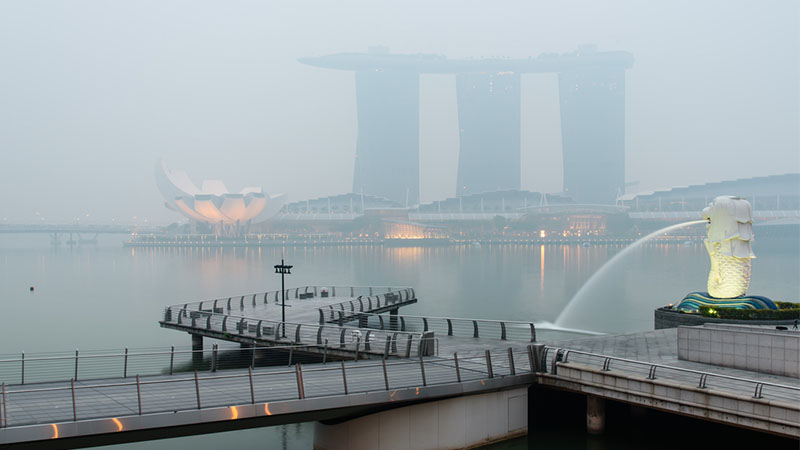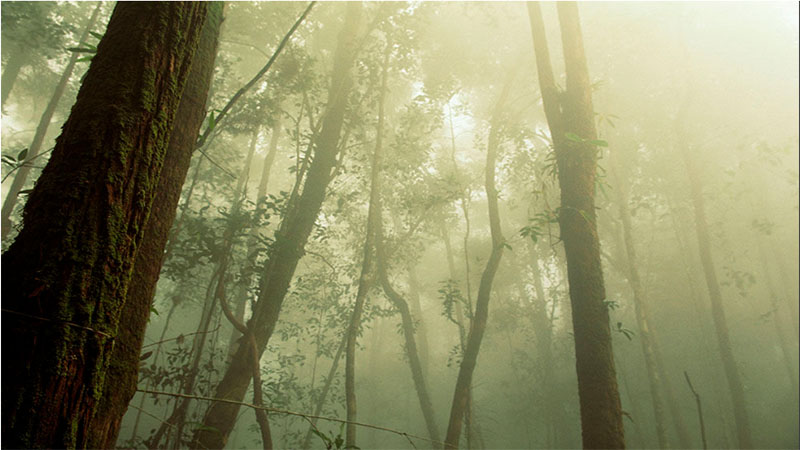By Katie Roberts
Like many people across the region, I was outraged back in 2015 by the weeks of haze that rolled into months, until it finally dissipated in early December with the arrival of the northeast monsoon. For me, it reached fever pitch on a long-awaited break in Phuket. On our much-anticipated boat trip to Phang Nga Bay, the sky was blanketed in smoke. To use a skiing analogy, it was a whiteout.

I found it incomprehensible that we could be cruising this normally stunning bay, trying to peer at the beautiful karst limestone formations through poor visibility caused by preventable fires raging hundreds of kilometres away. In one way, I wished I was like some of the tourists around me, who thought that the grey skies were just normal for this part of the world.
It got me thinking – not least because the inconvenience to me was so trivial compared to the serious health issues and innumerable disruptions to daily life that the haze causes to millions of people. What’s the truth behind these unhealthy skies? How does it relate to our consumption of palm oil? If the impact of the fires could spread so far into the region, what do the locals at ground zero think? And what can we as individuals do to help?
A perfect storm
Haze pollution stems from unsustainable “slash-and-burn” practices used in clearing land to make way for palm oil plantations. Singapore has been affected since the 1970s, owing to its proximity to Malaysia and Indonesia. 85 percent of global palm oil is produced in those two countries. Production of the oil rose from 10 million tonnes per year in 1990 to 50 million tonnes in 2018.
Tips for handling the haze
1. Keep track of the haze
Singapore’s National Environmental Agency (NEA) is one of the best resources for tracking the haze. From their main haze site you can quickly see the current PSI readings. PSI is the Pollution Standards Index used to determine a city’s current air quality, based on a scale of 0 to 300+. The NEA website has a helpful PSI chart that explains the index readings and what precautions people with different conditions or in different age groups should take.
There’s also a cool website called Haze Tracker. It provides some pretty in-depth information about the haze, including maps that track active fires and haze using various satellites.
2. Look into an air filter/purifier
These are always hot items this time of year, especially when the haze first arrives. In fact, many electronics stores run out of common models, but you should still be able to find a decent model at an appliance store. For optimal air purification, experts recommend devices that offers HEPA filtration and a layer of active carbon, which can remove over 99% of harmful particles.
3. A mask might be necessary
If you’re going to be outside for an extended period on days when the air pollution is ranked as very unhealthy or hazardous, it’s a good idea to wear a mask. Not just any mask; one that is rated as N95. This rating means it can block 95% of all particles in the air, including most viruses and haze particles. Wearing a surgical mask is often not enough, so stock up on a few N95 masks if you can. Be aware, however, that they only work when there is a tight seal around your mouth and nose. If there are gaps, the masks are more or less useless.
What can be done a larger scale?
According to Kim Stengert (Chief, Strategic Communication and External Relations at WWF-Singapore), the solution to haze pollution won’t come from one angle only. “To solve this problem, multiple parties need to act. Consumers must make the connection between the things they are purchasing and the growth of plantation agriculture in Indonesia. And they must start insisting on sustainable palm oil as the way forward.
“At the same time, companies growing palm oil and manufacturers and retailers using palm oil products must embrace a more sustainable way of doing business. Although many large palm oil companies have pledged not to convert any new natural forest, this needs to move from a code of conduct to governmental legislation to protect forests with high conservation value.
“And we need strong legislation with complete protection for peatlands. The current moratorium on them issued by the Indonesian President in October 2015 prevents planting on peat with a depth greater than three metres. WWF would like to see this extended to all peatlands, regardless of depth,” he says.

Local feelings
When the haze is particularly thick in the air in Singapore, dire reports come through of PSI readings hovering at 1,000 for locals living in hotspots. Yet, as recently as a few years ago, a report commissioned by the Round table on Sustainable Palm Oil (RSPO) showed that 59 percent of consumers surveyed in Indonesia viewed palm oil as mostly positive. Most respondents identified palm oil simply as cooking oil.
While they observe that palm oil provides jobs, increases the welfare of small holders and increases state revenue, their understanding about the impact on the environment and communities is low. In response to these results, the RSPO has developed a series of in-depth observations and recommendations for companies, governments and environmental groups.
Fact or fiction?
# It’s all Indonesia’s fault.
WWF says consumers have been driving the expansion of the palm oil industry through the things we buy. Palm oil is in 50 percent of the packaged goods on supermarket shelves. Plus, the majority of this oil is produced unsustainably, contributing to deforestation and affecting the wellbeing of local communities. Currently, only around 20 percent of the global palm oil supply is sustainable. WWF is campaigning to raise this percentage and make sustainable palm oil the norm.
# I can’t do anything to help it.
The WWF urges everyone to lend their voice to the campaign for a switch to sustainable palm oil. This support gives the organisation an even stronger argument when persuading manufacturers and retailers to buy sustainable palm oil products.
# If it’s not in the ingredient list, it doesn’t contain palm oil.
Palm oil can masquerade behind other names, most commonly as just vegetable oil, and it has become an accepted ingredient in everything from toothpaste to lipstick; but you are unlikely to see sustainable palm oil listed as such. WWF says consumers must put pressure on manufacturers and retailers to support sustainable palm oil options.
# Palm oil is bad; we should boycott it.
As the global population grows, so does the demand for commodities. Palm oil is the most used oil in the world, and a boycott on palm oil would merely see it replaced with another oil product. Currently, palm oil is the most efficient and versatile oil option, producing more yield per hectare than any alternative oil persuading manufacturers and retailers to buy sustainable palm oil products.
The palm oil industry has also lifted communities out of poverty, providing livelihoods and incomes that promise education and a brighter future for many. The answer, then, is to farm palm oil differently, in a sustainable way that limits adverse impacts on the environment.
Greenpeace International releases scorecards for global companies which make no-deforestation promises, judging them on their performance in three key areas: responsible sourcing of palm oil; transparency about their supply chain; and their support for wider industry reform. Find more info on this here.

Definitions to remember
- Pollution Standard Index (PSI): an air-quality index that is based on whichever of six pollutants is worst at the time – sulphur dioxide, particulate matter and fine particulate matter (PM2.5), nitrogen dioxide, carbon monoxide and ozone. For example, if PM2.5 concentration is the highest for the day, the PSI reading will be based on PM2.5.
- Fine particulate matter (PM2.5): particulate matter with a diameter of 2.5 microns or less. This is 20 to 30 times smaller than the thickness of a strand of hair. These particles are so small they can penetrate deeply into the lungs. They may even be able to cross into the blood. TheWorld Health Organisation has classified fine particulate matter as a cause of lung cancer.
- Peatlands: wetland areas composed of soil and made up of thousands of years of decaying vegetation. Peatlands store carbon which, when burned, is released as CO2, a major greenhouse gas and contributor to climate change. Palm oil companies divert water away from this fertile land to make it suitable for palm oil planting. Dried peatlands are like tinder and catch fire very easily. In 2015, 79 percent of fires in the region were on peatlands.
To help put an end to the haze, support a complete ban on planting on peat in Indonesia at wwf.sg/get_involved/the_haze.
For more helpful tips head to our Environment section
Fighting food waste in Singapore
Banning the plastic bag!
Animals up for adoption





